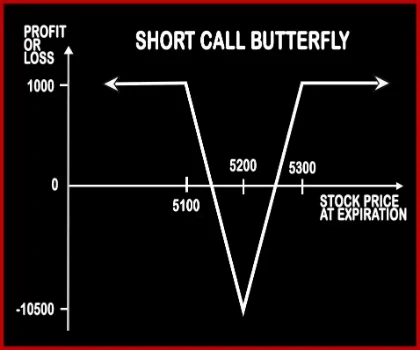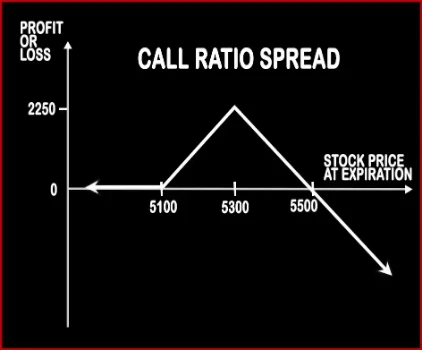Compare Strategies
| SHORT CALL BUTTERFLY | RATIO CALL SPREAD | |
|---|---|---|

|

|
|
| About Strategy |
Short Call Butterfly Option StrategyThis strategy is opposite of the Long Call Butterfly Strategy, a trader expects the market to remain range bound in Long Call Butterfly, but here he expects the market to move beyond strike boundaries in Short Call Butterfly. If the trader is bullish on the market’s volatility, he will implement this strategy. Here also there should be equal distance between the |
Ratio Call Spread Option StrategyAs the name suggests, a ratio of 2:1 is followed i.e. buy 1 ITM Call and simultaneously sell OTM Calls double the number of ITM Calls (In this case 2). This strategy is used by trader who is neutral on the market and bearish on the volatility in the near future. Here profits will be capped up to the premium amount and risk will be potentially unlimited since he is .. |
SHORT CALL BUTTERFLY Vs RATIO CALL SPREAD - Details
| SHORT CALL BUTTERFLY | RATIO CALL SPREAD | |
|---|---|---|
| Market View | Neutral | Neutral |
| Type (CE/PE) | CE (Call Option) | CE (Call Option) |
| Number Of Positions | 4 | 3 |
| Strategy Level | Advance | Beginners |
| Reward Profile | Limited | Limited |
| Risk Profile | Limited | Unlimited |
| Breakeven Point | Lower Break-even = Lower Strike Price + Net Premium, Upper Break-even = Higher Strike Price - Net Premium | Upper Breakeven Point = Strike Price of Short Calls + (Points of Maximum Profit / Number of Uncovered Calls), Lower Breakeven Point = Strike Price of Long Call +/- Net Premium Paid or Received |
SHORT CALL BUTTERFLY Vs RATIO CALL SPREAD - When & How to use ?
| SHORT CALL BUTTERFLY | RATIO CALL SPREAD | |
|---|---|---|
| Market View | Neutral | Neutral |
| When to use? | This strategy is meant for special scenarios where you foresee a lot of volatility in the market due to election results, budget, policy change, annual result announcements etc. | This strategy is used by trader who is neutral on the market and bearish on the volatility in the near future. Here profits will be capped up to the premium amount and risk will be potentially unlimited since he is selling two calls. |
| Action | Buy 2 ATM Call, Sell 1 ITM Call, Sell 1 OTM Call | Buy 1 ITM Call, Sell 2 OTM Calls |
| Breakeven Point | Lower Break-even = Lower Strike Price + Net Premium, Upper Break-even = Higher Strike Price - Net Premium | Upper Breakeven Point = Strike Price of Short Calls + (Points of Maximum Profit / Number of Uncovered Calls), Lower Breakeven Point = Strike Price of Long Call +/- Net Premium Paid or Received |
SHORT CALL BUTTERFLY Vs RATIO CALL SPREAD - Risk & Reward
| SHORT CALL BUTTERFLY | RATIO CALL SPREAD | |
|---|---|---|
| Maximum Profit Scenario | The profit is limited to the net premium received. | Strike Price of Short Call - Strike Price of Long Call + Net Premium Received - Commissions Paid |
| Maximum Loss Scenario | Higher strike price- Lower Strike Price - Net Premium | Price of Underlying - Strike Price of Short Calls - Max Profit + Commissions Paid |
| Risk | Limited | Unlimited |
| Reward | Limited | Limited |
SHORT CALL BUTTERFLY Vs RATIO CALL SPREAD - Strategy Pros & Cons
| SHORT CALL BUTTERFLY | RATIO CALL SPREAD | |
|---|---|---|
| Similar Strategies | Long Straddle, Long Call Butterfly | Variable Ratio Write |
| Disadvantage | • Limited rewards, usually offer smaller return. • Profitability depends on the significant movement of stocks and options prices. | • Unlimited potential loss. • Complex strategy with limited profit. |
| Advantages | • Even if the market is highly volatile, the risk exposure remains limited. • Without any extra investment, you can receive your premium. • Able to book profits even when the price movement cannot be predicted. | • Downside risk is almost zero. • Investors can book profit from share prices moving within given limits. • Trader can maximise profit when the share closes at the upper breakeven point. |